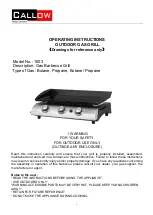
Switch action (Fig. 7)
CAUTION:
Before inserting the battery cartridge into the tool,
always check to see that the switch trigger actuates
properly and returns to the ‘‘OFF’’ position when
released.
To start the tool, simply pull the trigger. Tool speed is
increased by increasing pressure on the trigger.
Release the trigger to stop.
Reversing switch action (Fig. 8)
CAUTION:
• Always check the direction of rotation before opera-
tion.
• Use the reversing switch only after the tool comes to
a complete stop. Changing the direction of rotation
before the tool stops may damage the tool.
• When not operating the tool, always set the revers-
ing switch lever to the neutral position.
This tool has a reversing switch to change the direc-
tion of rotation. Depress the reversing switch lever
from the A side for forward rotation or from the B side
for reverse rotation. When the switch lever is in
between (the neutral position), the switch trigger
cannot be pulled.
Speed change (Fig. 9)
To change the speed, first switch off the tool and then
slide the speed change lever to the ‘‘
II
’’ side for high
speed or ‘‘
I
’’ side for low speed. Be sure that the
speed change lever is set to the correct position
before operation. Use the right speed for your job.
CAUTION:
• Always set the speed change lever fully to the
correct position. If you operate the tool with the
speed change lever positioned half-way between
the ‘‘
I
’’ side and ‘‘
II
’’ side, the tool may be damaged.
• Do not use the speed change lever while the tool is
running. The tool may be damaged.
Adjusting the fastening torque (Fig. 10)
The fastening torque can be adjusted in 17 steps by
turning the adjusting ring so that its graduations are
aligned with the pointer on the tool body. The fasten-
ing torque is minimum when the number 1 is aligned
with
the
pointer,
and
maximum
when
the
marking is aligned with the pointer.
The clutch will slip at various torque levels when set at
the number 1 to 16. The clutch is designed not to slip
at the
marking.
Before actual operation, drive a trial screw into your
material or a piece of duplicate material to determine
which torque level is required for a particular applica-
tion.
NOTE:
• The adjusting ring does not lock when the pointer is
positioned only half-way between the graduations.
• Do not operate the tool with the adjusting ring set
between the number 16 and the
marking. The tool
may be damaged.
Screwdriving operation (Fig. 11)
Place the point of the driver bit in the screw head and
apply pressure to the tool. Start the tool slowly and
then increase the speed gradually. Release the trig-
ger as soon as the clutch cuts in.
NOTE:
• Make sure that the driver bit is inserted straight in
the screw head, or the screw and/or bit may be
damaged.
• When driving wood screws, predrill pilot holes to
make driving easier and to prevent splitting of the
workpiece. See the chart below.
Nominal diameter of
wood screw (mm)
Recommended size of
pilot hole (mm)
3.1
2.0 – 2.2
3.5
2.2 – 2.5
3.8
2.5 – 2.8
4.5
2.9 – 3.2
4.8
3.1 – 3.4
5.1
3.3 – 3.6
5.5
3.6 – 3.9
5.8
4.0 – 4.2
6.1
4.2 – 4.4
• If the tool is operated continuously until the battery
cartridge has discharged, allow the tool to rest for
15 minutes before proceeding with a fresh battery.
Drilling operation
First, turn the adjusting ring so that the pointer on the
tool body points to the
marking. Then proceed as
follows.
• Drilling in wood
When drilling in wood, best results are obtained with
wood drills equipped with a guide screw. The guide
screw makes drilling easier by pulling the bit into the
workpiece.
• Drilling in metal
To prevent the bit from slipping when starting a hole,
make an indentation with a centerpunch and ham-
mer at the point to be drilled. Place the point of the
bit in the indentation and start drilling.
Use a cutting lubricant when drilling metals. The
exceptions are iron and brass which should be
drilled dry.
BDF460 (E) (’100. 4. 19)
7
Summary of Contents for BDF460
Page 2: ...1 2 3 4 5 6 1 2 3 4 2 5 7 6 9 8 0 q 9 w e r 7 8 t i p o y y u 2 ...
Page 3: ...9 10 11 12 13 a s d g f h j k l 3 ...
Page 74: ......
Page 75: ......
Page 76: ......
Page 77: ......
Page 78: ......
Page 79: ...79 ...








































